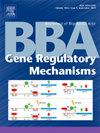Transposon insertion causes ctnnb2 transcript instability that results in the maternal effect zebrafish ichabod (ich) mutation
IF 3.1
3区 生物学
Q3 BIOCHEMISTRY & MOLECULAR BIOLOGY
Biochimica et Biophysica Acta-Gene Regulatory Mechanisms
Pub Date : 2025-06-30
DOI:10.1016/j.bbagrm.2025.195104
引用次数: 0
Abstract
The maternal-effect mutation ichabod (ich) results in ventralized zebrafish embryos due to impaired induction of the dorsal canonical Wnt-signaling pathway. While previous studies linked the phenotype to reduced ctnnb2 transcript levels, the causative mutation remained unidentified. Using long-read sequencing, we discovered that the ich phenotype stems from the insertion of a non-autonomous CMC-Enhancer/Suppressor-mutator (CMC-EnSpm) transposon in the 3’UTR of the gene. Through reporter assays, we demonstrate that while wild type ctnnb2 mRNAs exhibit remarkably high stability throughout the early stages of development, the insertion of the transposon dramatically reduces transcript stability. Genome-wide mapping of the CMC-EnSpm transposons across multiple zebrafish strains also indicated ongoing transposition activity in the zebrafish genome. Our findings not only resolve the molecular basis of the ich mutation but also highlight the continuing mutagenic potential of endogenous transposons and reveal unexpected aspects of maternal transcript regulation during early zebrafish development.
转座子插入导致ctnnb2转录不稳定,导致母体效应斑马鱼ichabod (rich)突变。
母体效应突变ichabod (ich)导致斑马鱼胚胎腹化,这是由于背部典型wnt信号通路的诱导受损。虽然先前的研究将表型与ctnnb2转录物水平降低联系起来,但致病突变仍未确定。通过长读测序,我们发现丰富的表型源于在基因的3'UTR中插入一个非自主的cmc -增强子/抑制子-突变子(CMC-EnSpm)转座子。通过报告者实验,我们发现野生型ctnnb2 mrna在早期发育阶段表现出非常高的稳定性,但转座子的插入显著降低了转录物的稳定性。CMC-EnSpm转座子在多个斑马鱼菌株中的全基因组定位也表明斑马鱼基因组中正在进行转座子活性。我们的发现不仅解决了丰富突变的分子基础,还强调了内源性转座子的持续致突变潜力,并揭示了斑马鱼早期发育过程中母体转录调控的意想不到的方面。
本文章由计算机程序翻译,如有差异,请以英文原文为准。
求助全文
约1分钟内获得全文
求助全文
来源期刊
CiteScore
9.20
自引率
2.10%
发文量
63
审稿时长
44 days
期刊介绍:
BBA Gene Regulatory Mechanisms includes reports that describe novel insights into mechanisms of transcriptional, post-transcriptional and translational gene regulation. Special emphasis is placed on papers that identify epigenetic mechanisms of gene regulation, including chromatin, modification, and remodeling. This section also encompasses mechanistic studies of regulatory proteins and protein complexes; regulatory or mechanistic aspects of RNA processing; regulation of expression by small RNAs; genomic analysis of gene expression patterns; and modeling of gene regulatory pathways. Papers describing gene promoters, enhancers, silencers or other regulatory DNA regions must incorporate significant functions studies.

 求助内容:
求助内容: 应助结果提醒方式:
应助结果提醒方式:


